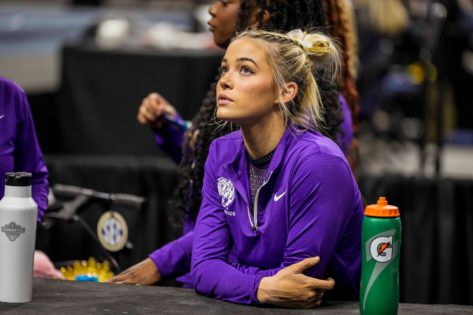“The more you do right, the more people try to knock you down.” That’s what Livvy Dunne has learned the hard way. Olivia Dunne knows the internet well enough to see the pattern. A major magazine cover. A national campaign. A viral post. Every time she edges forward, the backlash arrives just as swiftly. Praise may echo across platforms, but criticism waits in ambush. After half a decade of balancing NCAA gymnastics with a high-profile online persona, Dunne has developed her own rulebook, one that now includes a critical shift: no more vulnerability.
Though she continues to command enormous attention, most recently spotted at the MLB All-Star festivities with her boyfriend, Pittsburgh Pirates pitcher Paul Skenes, Dunne’s digital presence today is notably more controlled than in years past.
She still posts the standout moments. The high-profile events, the brand collaborations, the stadium-side cheers. But what she no longer shares, and why, reveals the cost of public openness.
Speaking on WWE executive Stephanie McMahon’s What’s Your Story podcast, Dunne explained her evolving approach. “You truly can’t compare yourself,” she said, reflecting on the curated nature of social media. “My Instagram feed is all of my accomplishments… it’s a highlight reel.” The issue, she implied, isn’t in sharing joy. It’s in sharing anything that might be taken the wrong way, and then weaponized.
One moment, in particular, changed her perspective. After opening up online about the repeated invasions of privacy she faced, strangers showing up at airports, tracking her travel schedule, demanding autographs, Olivia Dunne expected a conversation about boundaries. Instead, she was met with indifference and, at times, hostility. “Usually anytime I try to be vulnerable online, I get really bad backlash,” she admitted. “Because of the position I’m in, people are like, ‘We don’t care.’”
That response was not just disheartening. It was decisive. For Dunne, it marked a turning point. Vulnerability, she realized, was not a currency she could trade in. Her visibility, while empowering, came with a degree of exposure that others might never fully understand. “There are some boundaries, and they crossed mine,” she said plainly. And while she has security available when needed, the emotional guardrails are now firmly in place.
Rather than retreat entirely, Dunne has chosen to sharpen her filters. She blocks. She unfollows. She curates. “You get to not share what you don’t want to share,” she emphasized. In doing so, she has preserved the parts of her life that matter most—without opening the door to unwelcome commentary. The lesson was not just learned, but was also implemented.
Olivia Dunne reveals the harsh truth that changed how she uses social media
Olivia Dunne did not step into the public eye intending to confront a crisis of self-image. But once recognition became routine and her visibility surged beyond the confines of the gym, she encountered a dilemma that few athletes are equipped to face. Expectations of aesthetic perfection crept into her training life, not as part of the sport, but as a consequence of its growing audience. Dunne admitted, “I had a hard time balancing, you know,” caught between the demands of elite performance and the quiet yet constant pressure to appear flawless. She began to question whether the body built for competition could coexist with one sculpted for admiration.
This dissonance led to a period of quiet erosion—one where even routine edits on photographs felt less like vanity and more like necessity. “I truly was not confident in myself,” Dunne said. The filter became less about public presentation and more about private reassurance, a gesture toward control in an environment where scrutiny arrived in thousands of comments. That pressure, once silent, grew persistent. Even food became a source of indecision: Should she eat to fuel, or to fit an image? The conflict was not theoretical. It was daily, personal, and consuming.
Recovery did not follow a triumphant breakthrough. It unfolded in fragments, shaped by patient recalibration. “It was a timely process to learn to love those muscles,” she told Stephanie McMahon. Confidence, she emphasized, did not arrive in an instant. It was modeled, encouraged, and deliberately chosen. The turning point was not when the cameras flashed, but when she looked at the image and recognized herself—athlete, not ornament.
The post Olivia Dunne Reveals One Hard Lesson That Changed Her Approach to Social Media appeared first on EssentiallySports.
